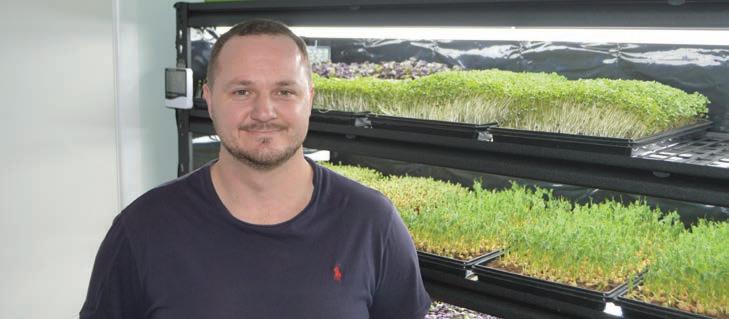
4 minute read
Onions NZ Inc
PREPARING NEW ZEALAND’S
ONION GROWERS FOR A DIGITAL FUTURE
Kazi Talaska : Onions NZ Inc. market access manager
Onions New Zealand has been undertaking work to understand the Information Technology (IT) and data requirements of New Zealand’s vegetable industry.
This has involved collaboration with growers, agronomists and technology providers to understand how IT systems and data are being used, what solutions are currently available in the market and what we will require to futureproof the industry for the years to come. The vegetable industry is seeing increasing requirements for compliance, supply chain traceability and export market legislation – all of which will require supporting information systems and tools to collect and manage the underlying data needed, from farm to plate. A grower survey was conducted to understand the use of data and systems on-farm. Vegetable growers were asked to provide information on the IT systems they currently use and what functions they use those systems for: administration, accounting, production management, farm mapping? Here are some insights from a sample of growers who completed the survey:
Many platforms don’t talk to each other
New Zealand growers use a range of online farm management platforms for operations. In many cases, each of these platforms is used for different on-farm purposes. For example, one might be used for agrichemical usage and irrigation logging, while another might be used for farm mapping. Because each growing operation is different, it makes sense to use a variety of ready-made solutions available on the market to suit your system. However, the end result is often siloed data that cannot be integrated. On-farm calculations of carbon emissions, for example, requires an understanding of all farm inputs and operations such as fertiliser applications and fuel use; thus, having the complete set of data and systems that integrate (talk to each other) is important. Unfortunately, systems providing complete and integrated data solutions are costly. One grower highlighted that an Application Programming Interface (API) that connects platforms together was too expensive and hard to justify the up-front investment.
Production management systems capture input costs but are not integrated with fertiliser, chemical or other inventory systems – giving a ’rough idea’ for GLOBALG.A.P. compliance.
Leading software is not tailored to the New Zealand growing system
Many off-the-shelf software applications available to New Zealand growers have been developed overseas – usually in the United Kingdom. The outcome is software that is not fit for purpose or customised for New Zealand’s growing system, leaving identified gaps in functionality. No one platform can perform all requirements on-farm. One surveyed grower said, “Off the shelf production management systems do not handle the complexity of intensive horticulture” and “high-rotation, multi-crop businesses are far more complicated.”
Into the cloud
Although a few growers still use on-premise or desktopinstalled software, most have now migrated to the ’cloud’, procuring ’software as a service’ applications, such as Xero and Figured, which work within a standard web browser and
provide enterprise levels of security and hosting. Cloudbased software is also helpful in that it works on mobile phones out in the field, subject to internet data connectivity.
New software automates your business processes or adds time?
Concerns were also raised around the amount of time needed for manual entry of data and the overall quality of data captured. For example, changing and splitting of paddocks that is common in vegetable rotation operations adds further complication to digitising farm records.
Variability across the sector
Large variability exists between how vegetable growers manage their IT systems and data. Microsoft Office 365 is the most popular platform among growers for basic productivity and collaboration. Muddy Boots (Telus Agriculture) is the most commonly used production management and spray diary software among those surveyed, but there are more than ten other production software vendors and products identified to be in use throughout New Zealand’s horticulture sector. On the other hand, there remains a subset of growers who still manage a large part of their operation through spreadsheets and paper-based systems. Only 37.5 percent of respondents said they managed their IT in-house, compared to 62.5 percent of respondents who said they use an external IT service partner. On the question of IT governance, 50 percent of the survey respondents have a cybersecurity plan and continuity plan in place.
37.5%

So how do we ensure onion growers – and the wider horticulture sector – has a fit-for-purpose, competitive technology ecosystem that supports growers’ needs and requirements? How do we get the right tools in front of growers to keep up with upcoming regulatory changes? And how do we support that transition and system longevity? What is clear, is that IT and data management is going to be increasingly important for industry in the future, but investment and successful adoption will be challenging. Growers need the tools to readily respond to changes in data requirements, and wider industry needs to begin investing in increased IT and data capabilities to effectively tackle forthcoming requirements for quality, compliance, traceability and export legislation. Onions New Zealand is looking at the next steps for data management in the onion sector. In the next year, we will be exploring different options for data providers, governance groups and story-telling platforms. The full IT systems report for the vegetable sector will be available on the Onions New Zealand resource library accessed from onionsnz.com through your grower login.











